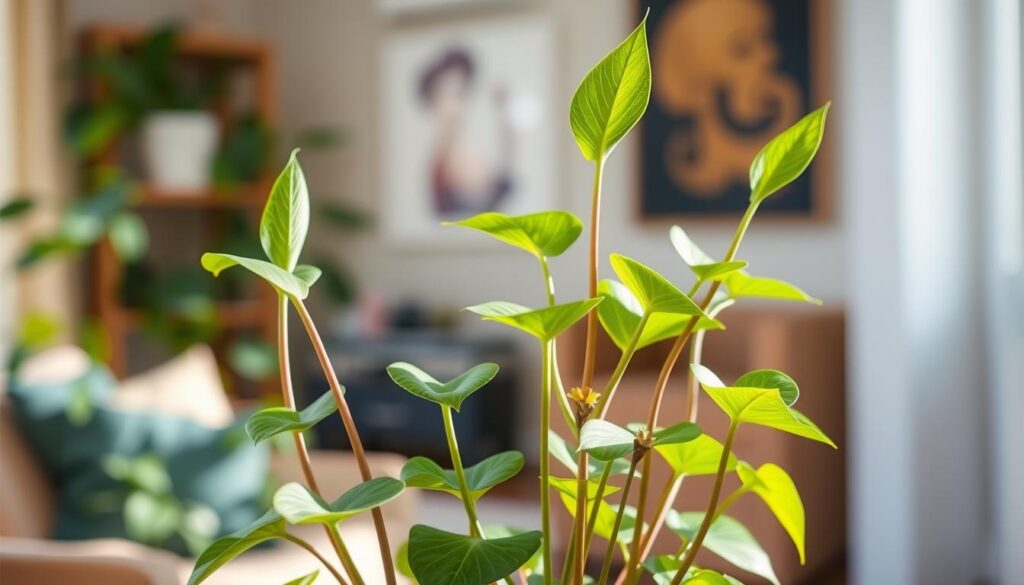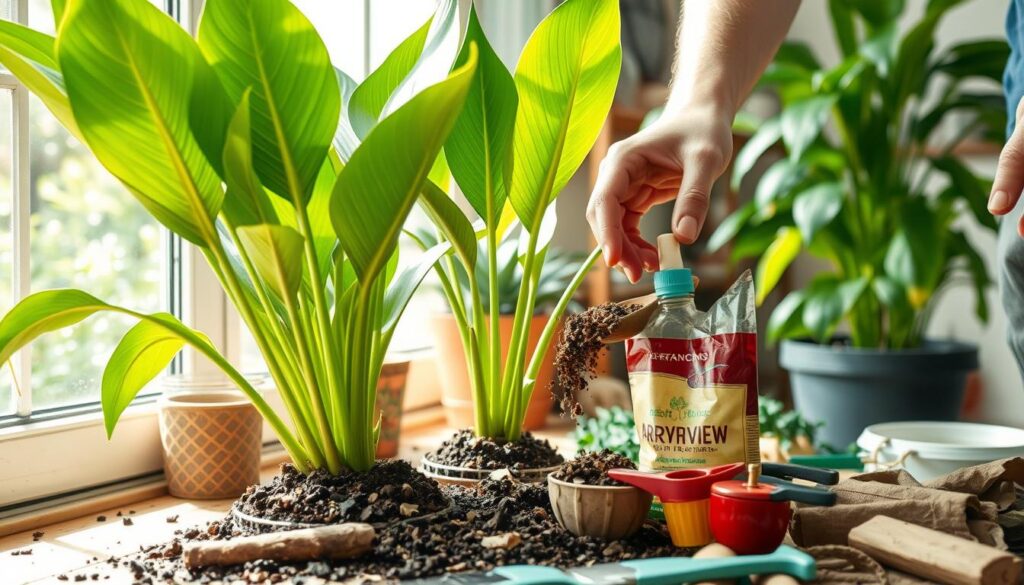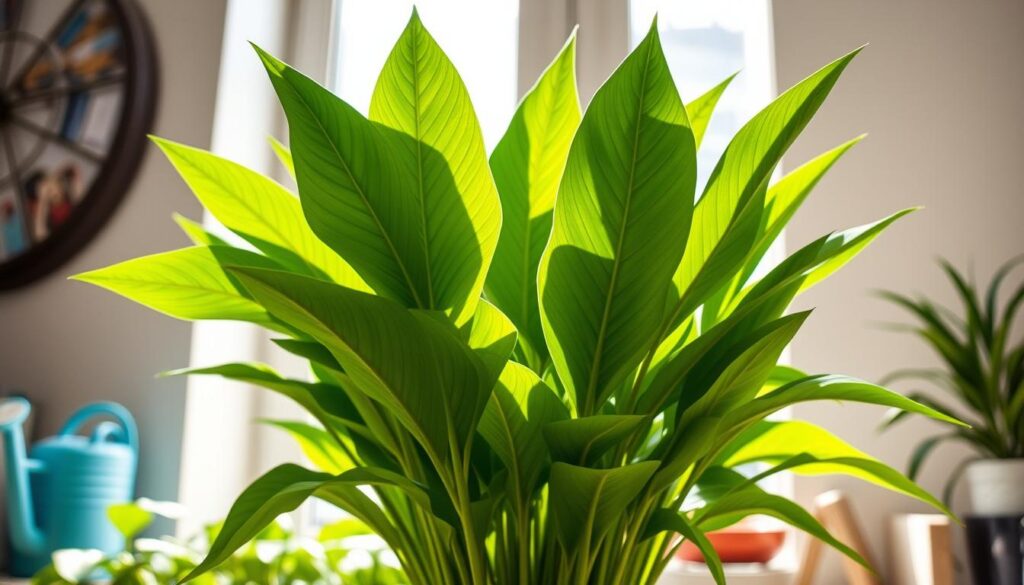Arrowhead plants are loved for their beautiful leaves and easy care. But, they can get leggy if not cared for right. A leggy plant has sparse leaves and too much stem, often from not enough light or stress.
These plants do best in humid places with the right temperature. They need the right amount of water and food to stay healthy. Too much water can rot the roots, while too little can cause nutrient problems.
Knowing how to spot a leggy plant and how to care for it is key. With the right care, your plant will grow strong and look great. Taking good care of your plant means paying attention to its needs and making sure it has what it needs to thrive.
Table of Contents
What is a Leggy Arrowhead Plant?
A leggy arrowhead plant has long, thin stems and sparse leaves. This happens when it doesn’t get enough light or is not cared for right. You can spot it by its stretched-out stems and leaves that are far apart, making it look sparse.
There are many arrowhead plant varieties. Each one has its own look and how it grows. For example, the classic Syngonium podophyllum and the Pink Allusion are popular. But, they can get leggy if they don’t get enough bright, indirect light and regular pruning.
Description and Characteristics
Arrowhead plants grow fast, sometimes up to 7 feet tall indoors. A small pot can grow a lot in just one to two years. To stop them from getting leggy, they need the right care, like regular pruning and enough light.
Common Varieties
Some Syngonium varieties are made to stay small and grow slower. They’re perfect for people who don’t want their plants to look leggy. By picking the right variety and caring for it well, you can have a healthy, beautiful arrowhead plant.
Regular tip pruning helps prevent legginess. It involves cutting off 2 to 5 leaves and their stems from the end of each main stem. With the right care and attention, your arrowhead plant will stay healthy and look great.
Why Do Plants Become Leggy?
Plants can become leggy for many reasons, with not enough light being a big one. A leggy arrowhead plant often happens when it doesn’t get enough light. This leads to long, thin stems. To understand why plants become leggy, we need to look at what causes it.
Arrowhead plants love bright, indirect light. Without enough light, they stretch out and become sparse. Insufficient light makes them reach for the light, making them look leggy.
Causes of Leggy Growth
- Lack of light: Plants need light to make food through photosynthesis. Without enough, they stretch out.
- Environmental stressors: Changes in temperature, humidity, or watering can stress the plant. This stress can make it grow leggy.
To stop or fix a leggy arrowhead plant, you need to give it the right light and keep its environment stable. Knowing why plants grow leggy helps you take steps to make your arrowhead plant healthy and bushy.
| Lighting Conditions | Plant Response |
|---|---|
| Low Light | Leggy growth, sparse leaves |
| Medium Light | Healthy growth, balanced leaves |
| High Light | Bushy growth, dense leaves |
Signs Your Arrowhead Plant is Leggy
Arrowhead plants can become leggy for several reasons. These include not enough light and not pruning them right. A leggy arrowhead plant has too much stem and sparse leaves. If your plant is getting leggy, you need to act fast. Experts on arrowhead plant care say giving it bright, indirect light can stop it from getting leggy.
Some common signs of a leggy arrowhead plant include:
- Excessive stem growth, which can cause the plant to become top-heavy and prone to falling over
- Sparse leaves, which can make the plant look unhealthy and unattractive
To fix these problems, you need to know why your plant is getting leggy. Then, you can prune it and give it the right light, as houseplant care specialists suggest.
By spotting the signs of a leggy arrowhead plant and acting quickly, you can help it grow back to its natural shape. This will promote healthy growth.
How to Identify a Leggy Arrowhead Plant
To spot a leggy arrowhead plant, look for certain signs. These plants have long, thin stems and few leaves. They look different from a healthy plant, which has lots of leaves and sturdy stems.
Here are some signs of a leggy arrowhead plant:
- Long, thin stems that are weak and prone to breaking
- Sparse leaves that are far apart on the stem
- A lack of dense foliage, giving the plant a sparse and leggy appearance
By noticing these signs, you can tell if your plant is leggy. With the right care, it can become healthy again.
Keeping an eye on your plant is key to avoiding legginess. Make sure it gets enough light, water, and nutrients. This will help it grow strong and healthy.
| Characteristics | Healthy Arrowhead Plant | Leggy Arrowhead Plant |
|---|---|---|
| Stem length | Short to medium | Long and thin |
| Leaf density | Dense and full | Sparse and far apart |
Reviving a Leggy Arrowhead Plant
To revive a leggy arrowhead plant, you need to understand its growth habits and environment. Knowing why it’s leggy helps you make it healthier and bushier. Pruning is a key method to control its height and make it fuller.
When pruning, cut the longest stems to half their length, just above a node. Do this often to keep the plant the right size and shape. Also, make sure it gets the right light. A leggy plant often needs more light, causing it to stretch. Place it in a spot with bright, indirect light to help it grow more compactly.
- Prune regularly to maintain shape and size
- Provide bright, indirect light to reduce legginess
- Monitor and adjust environmental conditions as necessary
By following these tips and using the right pruning techniques, you can make your leggy arrowhead plant healthier and more attractive.
| Pruning Frequency | Lighting Conditions | Expected Outcome |
|---|---|---|
| Regular | Bright, Indirect | Bushy Growth |
| Infrequent | Low | Leggy Growth |
Proper Watering for Healthy Growth
Watering your leggy arrowhead plant right is key for its health. These plants like moist soil but too much water can harm them. To keep them safe, learn how much water they need and water them just right. Knowing about the arrowhead plant’s water needs is important for their care.
Water your arrowhead plant when the top inch of soil feels dry. In spring and summer, they need more water. But in winter, water them less, letting the soil dry a bit between waterings. Proper watering stops them from getting too dry or too wet.

Understanding Moisture Needs
To see if your plant needs water, check the soil. If it’s dry, it’s time to water. You can also use a moisture meter. By knowing your plant’s water needs and watering them right, you help them grow well.
Avoiding Overwatering
Don’t overwater to avoid root rot and other problems. Water your plant but don’t do it too often. Also, avoid getting water on the leaves or crown. By following these tips, you can keep your plant healthy and strong.
Best Soil for Arrowhead Plants
To keep your arrowhead plant from getting leggy, the right soil is key. You want a mix that drains well to avoid root rot. A blend of all-purpose potting soil, perlite, and sphagnum peat moss works best.
Choosing the Right Soil Mix
The soil mix you choose greatly affects your plant’s health and look. It should drain well, hold moisture, and be rich in nutrients. Here are some great ingredients for your mix:
- Perlite to enhance drainage
- Sphagnum peat moss for moisture retention and pH balance
- Worm castings or compost for nutrient richness
Importance of Drainage
Drainage is vital for arrowhead plants to avoid waterlogged soil and root rot. Regularly check the soil and aerate it if needed. A mix that drains well keeps your plant healthy and prevents it from becoming leggy.
Fertilizing Your Arrowhead Plant
Fertilizing is key to keeping your leggy arrowhead plant healthy and looking good. From spring to summer, your plant needs regular food to grow well. Use a balanced fertilizer, like 10-10-10 or 20-20-20, to give it the nutrients it needs.
It’s important to find the right balance when fertilizing. Too much can make your plant grow too tall, and too little can slow it down. Fertilize your plant once a month when it’s growing, and every other month when it’s not. Always check the instructions on the fertilizer to make sure you’re using the right amount.

- Use a balanced fertilizer with a ratio of 10-10-10 or 20-20-20
- Fertilize once a month during the active growing season
- Reduce fertilization frequency to every other month during the dormant phase
- Follow packaging instructions to avoid over- or under-fertilization
By following these tips, you can help your arrowhead plant grow strong and stay vibrant. This will make your plant a beautiful addition to your home.
Propagation Techniques
For gardeners wanting to grow new plants from their leggy arrowhead plant, there are good options. You can use different methods to make new plants. Leaf propagation and the division method are two popular choices.
Timing is key when you’re propagating plants. The best time to do this is in early spring or summer. This is when the plants are growing the most. Choose healthy cuttings, about 8 to 18 inches long, for the best results.
- Initial root emergence typically occurs within 6 to 7 days post-cutting.
- Root formation after placing cuttings in water usually takes around two weeks.
- Cuttings in soil should be watered every 4 to 5 days, maintaining soil moisture without saturation.
By following these tips and using the right methods, you can grow new arrowhead plants. This will help your plants grow strong and healthy.
Preventing Legginess in the Future
To stop your arrowhead plant from getting leggy, give it the best growing conditions. Make sure it gets bright, indirect light and water it regularly. Also, prune and fertilize it often to keep it bushy.
Here are some tips to avoid legginess:
- Prune the plant often to make it bushy
- Give it enough light, but not direct sunlight to avoid scorching
- Water it consistently to avoid too much water
- Fertilize it regularly to give it the nutrients it needs
By following these tips, you can keep your arrowhead plant healthy and prevent legginess. Always check on your plant and adjust its care as needed. This will help it grow well and stay healthy.

It’s very important to prevent legginess in your arrowhead plant. By giving it the right care, it will grow strong and healthy. This way, you can avoid legginess in the future.
| Plant Care Tip | Benefit |
|---|---|
| Regular Pruning | Encourages bushy growth and prevents legginess |
| Consistent Watering | Prevents overwatering and promotes healthy growth |
| Fertilization | Provides essential nutrients for optimal growth |
Seasonal Care for Arrowhead Plants
It’s key to give your leggy arrowhead plant the right care for its health and look. In winter, water it less because it needs less moisture. But in summer, water it more often to keep the soil moist.
Think about the temperature and humidity too. Arrowhead plants do best in temperatures between 65 and 75 degrees Fahrenheit. They also like humidity above 60%. Here are some tips to help:
- Water your plant less in winter to avoid too much water.
- Water it more in summer to keep the soil moist.
- Keep the temperature between 65-75 degrees Fahrenheit for best growth.
- Make sure humidity is above 60% to prevent dry leaves.
By following these care tips, you can stop your arrowhead plant from getting leggy. Watch how your plant reacts to different conditions and change your care as needed.
Troubleshooting Common Issues
Keeping your leggy arrowhead plant healthy is key. Watch out for pests like spider mites, aphids, and mealybugs. They love to feed on the leaves. Use organic insecticidal soap or neem oil to fight them off. Also, keep affected plants away from others to stop the problem from spreading.
Your arrowhead plant might get sick too. Look for signs of fungal or bacterial infections. If you see any, treat it fast with the right medicine. This will help your plant get better and avoid more problems.
By paying attention to your arrowhead plant and fixing issues quickly, it will do great. With the right care, it will grow strong and beautiful. Your indoor garden will be even more stunning with a healthy, thriving plant.
Frequently Asked Questions
How to prune a leggy Arrowhead Plant?
To prune a leggy Arrowhead Plant, first identify the long, thin stems. Use sharp, clean scissors or pruning shears to trim them back to a healthy point. Cut just above a leaf node, which is the small bump where a leaf buds. This encourages new growth from that point, helping the plant become fuller.
Pruning regularly is key to keeping your Arrowhead Plant looking compact and healthy. It’s a simple yet effective way to maintain the plant’s appearance and promote its overall health.
How do I make my Arrowhead Plant bushy?
To make your Arrowhead Plant bushier, prune back the leggy stems, leaving a few nodes behind. You can also pinch the tips of the plant’s stems to promote lateral growth. Additionally, ensure the plant gets enough light (but not direct sunlight) and is in well-draining soil to encourage healthy growth.
How do I get my Arrowhead Plant to stand up?
Arrowhead Plants can grow quite wild. To keep them tidy, you can use stakes or a trellis. This helps them stand upright.
Use soft plant ties to gently tie the stems to the support. Or, you can prune the longer stems. This encourages a more compact, upright shape.
What to do when a plant gets too leggy?
When a plant becomes leggy, it typically means it’s not getting enough light or is growing unevenly. Trim back the leggy parts, move the plant to a brighter spot (not direct sun), and ensure it’s watered and fertilized correctly. Regular pruning will encourage healthier, bushier growth.
How do you make a leggy plant bushy?
To make a leggy plant bushy, prune the longer stems, removing leggy growth. This promotes lateral growth, encouraging the plant to grow more densely. Sufficient light and proper care will help the plant thrive and become bushier.
What does an overwatered Arrowhead Plant look like?
An overwatered Arrowhead Plant will have yellowing leaves, soft or mushy stems, and a wilting appearance despite being kept moist. The soil will often be soggy, and the roots might start to rot. Ensure you’re not watering too frequently and that the plant has well-draining soil to prevent root rot.

